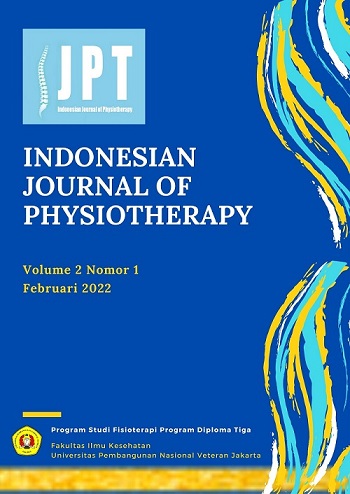EFEKTIVITAS VIRTUAL REALITY TERHADAP REHABILITASI CHRONIC ANKLE INSTABILITY: LITERATURE REVIEW
DOI:
https://doi.org/10.52019/ijpt.v2i1.3324Kata Kunci:
Kata kunci, Chronic ankle instability, Exergame, Functional ankle instability, Virtual reality trainingAbstrak
ABSTRAK
Latar Belakang: Ankle sprain merupakan cedera yang paling sering terjadi pada populasi aktif. Ankle sprain dapat berkembang menjadi chronic ankle instability yang menimbulkan berbagai permasalahan sehingga menyebabkan keterbatasan fungsional dan mempengaruhi kualitas hidup. Virtual reality menghadirkan simulasi lingkungan interaktif, realistis, menarik dan aman digunakan sehingga bermanfaat untuk meningkatkan kemampuan fungsional penderita chronic ankle instability. Tujuan: Untuk menyajikan bukti terkini terkait efektifitas virtual reality terhadap rehabilitasi chronic ankle instability, seperti kekuatan otot, keseimbangan, stabilitas ankle, dan performa melalui studi literatur. Metode: Literature review dengan framework PICOT(T) (Population, Intervention, Comparison, Outcome, Time, (Type of study)). Pencarian artikel menggunakan 4 database (PubMed Central, PubMed, Proquest, dan Google Scholar) dengan kata kunci yang telah dibuat, seleksi artikel menggunakan flowchart, dan penilaian kritis artikel. Hasil: Hasil keseluruhan pencarian dari 4 database diperoleh 852 artikel. Setelah dilakukan screening berdasarkan kriteria inklusi dan kriteria eksklusi, diperoleh 7 artikel yang menunjukkan efektivitas penggunaan virtual reality terhadap rehabilitasi chronic ankle instability. Kesimpulan: Berdasarkan literature review, mengungkapkan bahwa latihan berbasis virtual reality efektif terhadap rehabilitasi pasien chronic ankle instability.
Kata kunci: Chronic ankle instability; Exergame; Functional ankle instability; Virtual reality training
ABSTRACT
Background: Ankle sprain is injury that often occur in the active population. Ankle sprain may develop chronic ankle instability which causes various impairments. Therefore, it leads to functional limitations and affects quality of life. Virtual reality provides an interactive, realistic, attractive, and safe environment simulation that is useful for improving physical function of chronic ankle instability patients. Objective: To provide up-to-date evidence related to the effectiveness of virtual reality on chronic ankle instability rehabilitation, such as muscle strengths, balance, ankle stability, and performance through literature review. Methods: A literature review with the PICOT(T) framework (Population, Intervention, Comparison, Outcome, Time, (Type of study)). The method's stages were articles search using 4 databases (PubMed Central, PubMed, Proquest, and Google Scholar with keywords that have been created, articles selection using flowchart, and critical appraisal of articles. Result: There were 852 articles obtained by the overall search of 4 databases. After screening articles based on inclusion criteria and exclusion criteria, 7 journals proved the effectiveness of the use of virtual reality on chronic ankle instability rehabilitation. Conclusion: According to the literature review, virtual reality-based exercise is effective on chronic ankle instability rehabilitation.
Keywords: Chronic ankle instability; Exergame; Functional ankle instability; Virtual reality training
Referensi
REFERENSI
Al-Mohrej, O. A., & Al-Kenani, N. S. (2016). Chronic ankle instability: Current perspectives. Avicenna Journal of Medicine, 6(4), 103. https://doi.org/10.4103/2231-0770.191446
Alvares, J. B., Rodrigues, R., Franke, R., Silva, B. G. C. da, Pinto, R. S., Vaz, M. A., & Baroni, B. M. (2015). Inter-machine reliability of the Biodex and Cybex isokinetic dynamometers for knee flexor/extensor isometric, concentric and eccentric tests. Physical Therapy in Sport, 16(1), 59–65. https://doi.org/10.1016/J.PTSP.2014.04.004
Ambrose, A., Paul, G., & Hausdorff, J. (2013). Risk factors for falls among older adults: a review of the literature. Maturitas, 75(1), 51–61. https://doi.org/10.1016/J.MATURITAS.2013.02.009
Arifin, N., Osman, N. A. A., & Abas, W. A. B. W. (2013). Intrarater test-retest reliability of static and dynamic stability indexes measurement using the Biodex Stability System during unilateral stance. Journal of Applied Biomechanics, 30(2), 300–304. https://doi.org/10.1123/JAB.2013-0130
Arnold, B. L., Wright, C. J., & Ross, S. E. (2011). Functional ankle instability and health-related quality of life. Journal of Athletic Training, 46(6), 634–641. https://doi.org/10.4085/1062-6050-46.6.634
Blasco, J., Igual-Camacho, C., Blasco, M., Antón-Antón, V., Ortiz-Llueca, lvaro, & Roig-Casasús, S. (2021). The efficacy of virtual reality tools for total knee replacement rehabilitation: A systematic review. Physiotherapy Theory and Practice, 37(6), 682–692. https://doi.org/10.1080/09593985.2019.1641865
Croy, T., Koppenhaver, S., Saliba, S., & Hertel, J. (2013). Anterior talocrural joint laxity: diagnostic accuracy of the anterior drawer test of the ankle. Journal of Orthopaedic & Sports Physical Therapy, 43(12), 911–919. https://doi.org/10.2519/JOSPT.2013.4679
Donovan, L., Hetzel, S., Laufenberg, C. R., & McGuine, T. A. (2020). Prevalence and impact of chronic ankle instability in adolescent athletes. Https://Doi.Org/10.1177/2325967119900962, 8(2). https://doi.org/10.1177/2325967119900962
Duque, G., Boersma, D., Loza-Diaz, G., Hassan, S., Suarez, H., Geisinger, D., Suriyaarachchi, P., Sharma, A., & Demontiero, O. (2013). Effects of balance training using a virtual-reality system in older fallers. Clinical Interventions in Aging, 8, 257. https://doi.org/10.2147/CIA.S41453
Farsi, A., Abdoli, B., & Baraz, P. (2015). Effect of balance, strength, and combined training on the balance of the elderly women. Iranian Journal of Ageing, 10(3), 54–61. http://salmandj.uswr.ac.ir/article-1-726-en.html
Faruhasa, Z. (2020). Relationship between gender, history of ankle sprain, and ankle stability with ankle sprain status. The Indonesian Journal of Public Health, 15(3), 276–285. https://doi.org/10.20473/ijph.vl15il.2020.276-285
Ferrari, R. (2015). Writing narrative style literature reviews. Medical Writing, 24, 230–235. https://doi.org/10.1179/2047480615Z.000000000329
Fiani, B., Siddiqi, I., Lee, S. C., & Dhillon, L. (2020). Telerehabilitation: development, application, and need for increased usage in the COVID-19 era for patients with spinal pathology. Cureus, 12(9). https://doi.org/10.7759/CUREUS.10563
Fort-Vanmeerhaeghe, A., Romero-Rodriguez, D., Montalvo, A. M., Kiefer, A. W., Lloyd, R. S., & Myer, G. D. (2016). Integrative neuromuscular training and injury prevention in youth athletes. part i: identifying risk factors. Strength and Conditioning Journal, 38(3), 36–48. https://doi.org/10.1519/SSC.0000000000000229
Fung, V., Ho, A., Shaffer, J., Chung, E., & Gomez, M. (2012). Use of Nintendo Wii FitTM in the rehabilitation of outpatients following total knee replacement: a preliminary randomised controlled trial. Physiotherapy, 98(3), 183–188. https://doi.org/10.1016/J.PHYSIO.2012.04.001
Galanopoulos, I., Garlapati, A., Ashwood, N., & Kitsis, C. (2012). A Wii virtual activity severe thumb metacarpal injury. BMJ Case Reports, 2012. https://doi.org/10.1136/BCR-2012-006967
Goble, D. J., Cone, B. L., & Fling, B. W. (2014). Using the Wii Fit as a tool for balance assessment and neurorehabilitation: the first half decade of “Wii-search.” Journal of NeuroEngineering and Rehabilitation 2014 11:1, 11(1), 1–9. https://doi.org/10.1186/1743-0003-11-12
Guillebastre, B., Calmels, P., & Rougier, P. (2013). Effects of muscular deficiency on postural and gait capacities in patients with Charcot-Marie-Tooth disease. Journal of Rehabilitation Medicine, 45(3), 314–317. https://doi.org/10.2340/16501977-1113
Ha, S.-Y., Han, J.-H., Sung, Y.-H., Ha, S.-Y., Han, J.-H., & Sung, Y.-H. (2018). Effects of ankle strengthening exercise program on an unstable supporting surface on proprioception and balance in adults with functional ankle instability. Journal of Exercise Rehabilitation, 14(2), 301–305. https://doi.org/10.12965/JER.1836082.041
Hershkovich, O., Tenenbaum, S., Gordon, B., Bruck, N., Thein, R., Derazne, E., Tzur, D., Shamiss, A., & Afek, A. (2015). Effects of resistance training on muscle strength, endurance, and motor unit according to ciliary neurotrophic factor polymorphism in male college students. The Journal of Foot and Ankle Surgery, 54(2), 183–187. https://doi.org/10.1053/J.JFAS.2014.06.001
Hiller, C., Nightingale, E., … J. R.-A. of physical, & 2012, U. (2012). Prevalence and impact of chronic musculoskeletal ankle disorders in the community. Elsevier, 93(10), 1801–1807. https://www.sciencedirect.com/science/article/pii/S000399931200319X
Hoch, M., & Mullineaux, D. (2016). Sagittal plane gait kinematics in individuals with chronic ankle instability. International Journal of Athletic Therapy and Training, 21(5), 28–35. https://doi.org/10.1123/ijatt.2015-0043
Hong, A.-R., Hong, S.-M., & Shin, Y.-A. (2014). Effects of Resistance Training on Muscle Strength, Endurance, and Motor Unit According to Ciliary Neurotrophic Factor Polymorphism in Male College Students. Journal of Sports Science & Medicine, 13(3), 680. /pmc/articles/PMC4126309/
Houston, M. N., Van Lunen, B. L., & Hoch, M. C. (2014). Health-related quality of life in individuals with chronic ankle instability. Journal of Athletic Training, 49(6), 758–763. https://doi.org/10.4085/1062-6050-49.3.54
Jain, T. K., Wauneka, C. N., & Liu, W. (2014). The effect of balance training on ankle proprioception in patients with functional ankle instability. Journal of Foot and Ankle Research, 7(Suppl 1), A37. https://doi.org/10.1186/1757-1146-7-S1-A37
Jalink, M. B., Heineman, E., Pierie, J.-P. E. N., & Hoedemaker, H. O. ten C. (2014). Nintendo related injuries and other problems: review. BMJ, 349. https://doi.org/10.1136/BMJ.G7267
Khalil, A. A., Mohamed, G. A., Rahman, S. M. A. El, Elhafez, S. M., & Nassif, N. S. (2016). Effect of Wiihabilitation on strength ratio of ankle muscles inadults. Journal of Physical Therapy Science, 28(10), 2862. https://doi.org/10.1589/JPTS.28.2862
Kim, E., Choi, H., Cha, J., & Park, J. (2017). Effects of neuromuscular training on the rear-foot angle kinematics in elite women field hockey players with chronic ankle instability. Journal of Sports & Science, 16(1), 137. https://www.ncbi.nlm.nih.gov/pmc/articles/pmc5358023/
Kim, J.-H., & Uhm, Y.-H. (2016). Effect of ankle stabilization training using biofeedback on balance ability and lower limb muscle activity in football players with functional ankle instability. The Journal of Korean Physical Therapy, 28(3), 189–194. https://doi.org/10.18857/JKPT.2016.28.3.189
Kim, K.-J., & Heo, M. (2015). Effects of virtual reality programs on balance in functional ankle instability. Journal of Physical Therapy Science, 27(10), 3097. https://doi.org/10.1589/JPTS.27.3097
Kim, K.-J., Jun, H.-J., & Heo, M. (2015). Effects of Nintendo Wii Fit Plus training on ankle strength with functional ankle instability. Journal of Physical Therapy Science, 27(11), 3381–3385. https://doi.org/10.1589/JPTS.27.3381
Kim, K. J. (2013). Impact of combined muscle strength and proprioceptive exercises on functional ankle instability. Journal of International Academy of Physical Therapy Research, 4(2), 600–604. https://doi.org/10.5854/JIAPTR.2013.10.25.600
Kim, Ki-jong, & Gang, M. (2020). Effect of taping and virtual reality combined exercise on static and dynamic balance with functional ankle instability. Physical Therapy Korea, 27(4), 292–297. https://doi.org/10.12674/PTK.2020.27.4.292
Kim, KJ. (2015). Effects of virtual reality programs on proprioception and instability of functional ankle instability. Journal of International Academy of Physical Therapy, 6(2), 891–895. https://www.koreascience.or.kr/article/JAKO201510254116627.page
Kim, KJ, Kim, Y., Jun, H., Lee, J., & ji, S. (2014). Which treatment is more effective for functional ankle instability: strengthening or combined muscle strengthening and proprioceptive exercises? Journal of Physical Therapy Science, 26(3), 385–388. https://www.jstage.jst.go.jp/article/jpts/26/3/26_jpts-2013-377/_article/-char/ja/
Kim, T. H., Lee, M. S., Kim, K. H., Kang, J. W., Choi, T. Y., & Ernst, E. (2014). Acupuncture for treating acute ankle sprains in adults. Cochrane Database of Systematic Reviews, 6. https://doi.org/10.1002/14651858.CD009065.PUB2
Kobayashi, T., Saka, M., Suzuki, E., Yamazaki, N., Suzukawa, M., Akaike, A., Shimizu, K., & Gamada, K. (2014). The effects of a semi-rigid brace or taping on talocrural and subtalar kinematics in chronic ankle instability. Foot and Ankle Specialist, 7(6), 471–477. https://doi.org/10.1177/1938640014543357
Kosik, K. B., Johnson, N. F., Terada, M., Thomas, A. C., Mattacola, C. G., & Gribble, P. A. (2019). Decreased dynamic balance and dorsiflexion range of motion in young and middle-aged adults with chronic ankle instability. Journal of Science and Medicine in Sport, 22(9), 976–980. https://doi.org/10.1016/J.JSAMS.2019.05.005
Kris, K., Marta, A., Ketut, I., & Kawiyana, S. (2016). Management of acute ankle sprain: a literature review. Indonesia Journal of Biomedical Science, 10(2), 20–26.
Lazarou, L., Kofotolis, N., Pafis, G., & Kellis, E. (2018). Effects of two proprioceptive training programs on ankle range of motion, pain, functional and balance performance in individuals with ankle sprain. Journal of Back and Musculoskeletal Rehabilitation, 31(3), 437–446. https://doi.org/10.3233/BMR-170836
Lin, C.-I., Houtenbos, S., Lu, Y.-H., Mayer, F., & Wippert, P.-M. (2021). The epidemiology of chronic ankle instability with perceived ankle instability- a systematic review. Journal of Foot and Ankle Research 2021 14:1, 14(1), 1–11. https://doi.org/10.1186/S13047-021-00480-W
Linens, S. W., Ross, S. E., Arnold, B. L., Gayle, R., & Pidcoe, P. (2014). Postural-stability tests that identify individuals with chronic ankle instability. Journal of Athletic Training, 49(1), 15–23. https://doi.org/10.4085/1062-6050-48.6.09
Mohammadi, N., Hadian, M. R., & Olyaei, G. (2020). The effects of Wii Fit Plus training on functional ability in athletes with functional ankle instability. Sports Orthopaedics and Traumatology, 36(1), 52–59. https://doi.org/10.1016/J.ORTHTR.2020.01.003
Nam, S., Kim, K., & Lee, D. Y. (2018). Effects of visual feedback balance training on the balance and ankle instability in adult men with functional ankle instability. Journal of Physical Therapy Science, 30(1), 113–115. https://doi.org/10.1589/JPTS.30.113
Nam, S., Kim, W., & Yun, C. (2016). Effects of balance training by knee joint motions on muscle activity in adultmen with functional ankle instability. Journal of Physical Therapy Science, 28(5), 1629. https://doi.org/10.1589/jpts.28.
O’Driscoll, J., Kerin, F., & Delahunt, E. (2011). Effect of a 6-week dynamic neuromuscular training programme on ankle joint function: A Case report. Sports Medicine, Arthroscopy, Rehabilitation, Therapy & Technology : SMARTT, 3(1), 13–13. https://doi.org/10.1186/1758-2555-3-13
Pessoa, T. M., Coutinho, D. S., Pereira, V. M., De Oliveira Ribeiro, N. P., Nardi, A. E., & De Oliveira e Silva, A. C. (2014). The Nintendo Wii as a tool for neurocognitive rehabilitation, training and health promotion. Computers in Human Behavior, 31(1), 384–392. https://doi.org/10.1016/J.CHB.2013.10.025
Pourkazemi, F., Hiller, C. E., Raymond, J., Black, D., Nightingale, E. J., & Refshauge, K. M. (2018). Predictors of recurrent sprains after an index lateral ankle sprain: a longitudinal study. Physiotherapy, 104(4), 430–437. https://doi.org/10.1016/J.PHYSIO.2017.10.004
Proske, U., & Gandevia, S. C. (2012). The proprioceptive senses: their roles in signaling body shape, body position and movement, and muscle force. Https://Doi.Org/10.1152/Physrev.00048.2011, 92(4), 1651–1697. https://doi.org/10.1152/PHYSREV.00048.2011
Punt, I., Ziltener, J., Laidet, M., Armand, S., & Allet, L. (2015). Gait and physical impairments in patients with acute ankle sprains who did not receive physical therapy. PM & R : The Journal of Injury, Function, and Rehabilitation, 7(1), 34–41. https://doi.org/10.1016/J.PMRJ.2014.06.014
Raymond, J., Nicholson, L. L., Hiller, C. E., & Refshauge, K. M. (2012). The effect of ankle taping or bracing on proprioception in functional ankle instability: a systematic review and meta-analysis. Journal of Science and Medicine in Sport, 15(5), 386–392. https://doi.org/10.1016/J.JSAMS.2012.03.008
Riva, J. J., Malik, K. M. P., Burnie, S. J., Endicott, A. R., & Busse, J. W. (2012). What is your research question? An introduction to the PICOT format for clinicians. The Journal of the Canadian Chiropractic Association, 56(3), 167. /pmc/articles/PMC3430448/
Roos, K. G., Kerr, Z. Y., Mauntel, T. C., Djoko, A., Dompier, T. P., & Wikstrom, E. A. (2016). The epidemiology of lateral ligament complex ankle sprains in National Collegiate Athletic Association Sports. Https://Doi.Org/10.1177/0363546516660980, 45(1), 201–209. https://doi.org/10.1177/0363546516660980
Rosen, A. B., Ko, J., & Brown, C. N. (2015). Diagnostic accuracy of instrumented and manual talar tilt tests in chronic ankle instability populations. Scandinavian Journal of Medicine & Science in Sports, 25(2), e214–e221. https://doi.org/10.1111/SMS.12288
Ruthenbeck, G. S., & Reynolds, K. J. (2014). Virtual reality for medical training: the state-of-the-art. Journal of Simulation 2014 9:1, 9(1), 16–26. https://doi.org/10.1057/JOS.2014.14
Shih, Y., Yu, H., Chen, W., Liao, K., & Lin, H. (2018). The effect of additional joint mobilization on neuromuscular performance in individuals with functional ankle instability. Physical Therapy in Sport, 30, 22–28. https://www.sciencedirect.com/science/article/pii/S1466853X17306739
Shousha, T., & Abo-zaid, N. (2021). Virtual reality versus Biodex training in adolescents with chronic ankle instability: a randomized controlled trial. Archives of Medical Science. https://doi.org/10.5114/aoms/134635
Son, S. M., Kang, K. W., Lee, N. K., Nam, S. H., Kwon, J. W., & Kim, K. (2013). Influence of isokinetic strength training of unilateral ankle on ipsilateral one-legged standing balance of adults. Journal of Physical Therapy Science, 25(10), 1313–1315. https://doi.org/10.1589/JPTS.25.1313
Switlick, T., Kernozek, T. W., & Meardon, S. (2015). Differences in joint-position sense and vibratory threshold in runners with and without a history of overuse injury. Journal of Sport Rehabilitation, 24(1), 6–12. https://doi.org/10.1123/JSR.2013-0089
Tanen, L., Docherty, C., Van Der Pol, B., Simon, J., & Schrader, J. (2014). Prevalence of chronic ankle instability in high school and division I athletes. Foot & Ankle Specialist, 7(1), 37–44. https://doi.org/10.1177/1938640013509670
Thompson, C., Schabrun, S., Romero, R., Bialocerkowski, A., van Dieen, J., & Marshall, P. (2018). Factors contributing to chronic ankle instability: a systematic review and meta-analysis of systematic review. Sports Medicine, 48(1), 189–205. https://doi.org/10.1007/S40279-017-0781-4
Trajković, N., & Bogataj, Š. (2020). Effects of neuromuscular training on motor competence and physical performance in young female volleyball players. International Journal of Environmental Research and Public Health 2020, Vol. 17, Page 1755, 17(5), 1755. https://doi.org/10.3390/IJERPH17051755
Vernadakis, N., Gioftsidou, A., Antoniou, P., Ioannidis, D., & Giannousi, M. (2012). The impact of Nintendo Wii to physical education students’ balance compared to the traditional approaches. Computers and Education, 59(2), 196–205. https://doi.org/10.1016/J.COMPEDU.2012.01.003
Wang, S. S. Y., Teo, W. Z. W., Teo, W. Z. Y., & Chai, Y. W. (2020). Virtual Reality as a bridge in palliative care during COVID-19. Journal of Palliative Medicine, 23(6), 756. https://doi.org/10.1089/JPM.2020.0212
Wardini, R., Dajczman, E., Yang, N., Baltzan, M., Préfontaine, D., Stathatos, M., Marciano, H., Watson, S., & Wolkove, N. (2013). Using a virtual game system to innovate pulmonary rehabilitation: Safety, adherence and enjoyment in severe chronic obstructive pulmonary disease. Canadian Respiratory Journal : Journal of the Canadian Thoracic Society, 20(5), 357. https://doi.org/10.1155/2013/563861
Watabe, T., Takabayashi, T., Tokunaga, Y., & Kubo, M. (2021). Individuals with chronic ankle instability exhibit altered ankle kinematics and neuromuscular control compared to copers during inversion single-leg landing. Physical Therapy in Sport, 49, 77–82. https://www.sciencedirect.com/science/article/pii/S1466853X21000341
Yamchi, R. F., Letafatkar, A., & Esmaeilpour, S. (2021). The effect of 8 weeks virtual reality training on static and dynamic balance and performance in male athletes with functional ankle instability. Physical Treatments - Specific Physical Therapy Journal, 11(1), 45–54. https://doi.org/10.32598/PTJ.11.1.453.1
Yu-Min, K., Mi-Suk, J., & Ji-Won, P. (2011). The relationship between strength balance and joint position sense related to ankle joint in healthy women. Journal of Korean Physical Therapy, 23(2), 23–29. http://www.kptjournal.org/journal/view.html?spage=23&volume=23&number=2
Zouita, A. B. M., Majdoub, O., Ferchichi, H., Grandy, K., Dziri, C., & Ben Salah, F. Z. (2013). The effect of 8-weeks proprioceptive exercise program in postural sway and isokinetic strength of ankle sprains of Tunisian athletes. Annals of Physical and Rehabilitation Medicine, 56(9–10), 634–643. https://doi.org/10.1016/J.REHAB.2013.08.003









